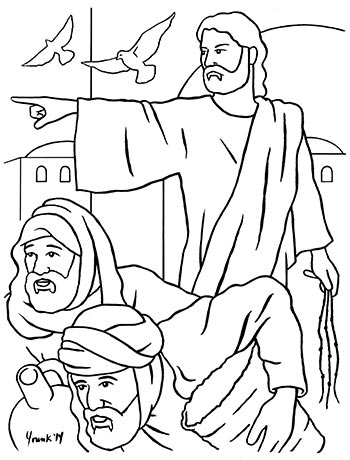Photo illustration by Phil Younk
Click on the photo for a printable PDF!
Worship is more than going through outward motions
Based on Ez 47:1-2, 8-9, 12; 1 Cor 3:9-11, 16-17; Jn 2:13-22
The Basilica of St. John Lateran is a holy place. It’s the cathedral of the pope as bishop of Rome and mother church of Catholicism.
In the fourth century, after the emperor Constantine converted to Christianity, he gave the pope property once owned by the Lateran family. The pope built a basilica there and on Nov. 9, 324, dedicated it to St. John the Baptist. We celebrate this dedication because when Emperor Constantine became a Christian, it brought an end to the persecution of Christians and brought about the freedom of worship for the early church.
In the Gospel we hear about another holy place – the temple in Jerusalem. When Jesus went to the temple, he saw the money changing and the selling and buying of animals. He made a whip out of rope cords and went from tables to counters to baskets and drove the sellers out of the temple. He spilled and scattered the coins of the moneychangers. To those selling doves, Jesus said, “Take these out of here, and stop making my Father’s house a marketplace.”
Why? It was Passover when thousands of people came to the temple to pray and offer sacrifices to God to fulfill the Jewish law. To buy animals needed for sacrifice and to pay the temple tax, people went to the moneychangers to exchange Roman coins for temple coins. The animals were slaughtered and offered as sacrifices to God. Jesus was offended by the selling, buying and exchanging of money that went beyond what was necessary – making the temple a marketplace rather than a house of prayer.
With a condemning, blazing look in his eyes, Jesus was so firm in what he said and did that the temple leaders didn’t dare stop him. They asked Jesus what right he had to do this. Jesus answered, “Destroy this temple, and in three days I will raise it up.”
The temple Jesus would rebuild was not the stone building in which he was now speaking, but his own body. Jesus would die on the cross and three days later would rise from the dead. The temple leaders didn’t know what he meant.
Jesus was also trying to help the temple leaders – and us – understand that worship means more than going through outward motions. It means looking inward to grow spiritually – opening our hearts to God and seeking his will, forgetting self and bringing love, justice, peace and mercy to others – as Jesus did.

